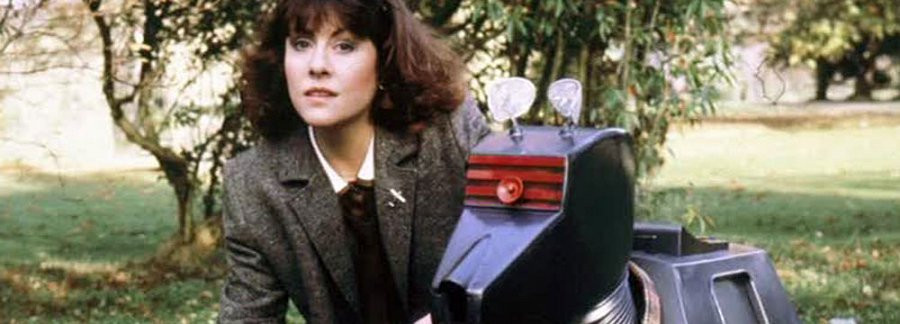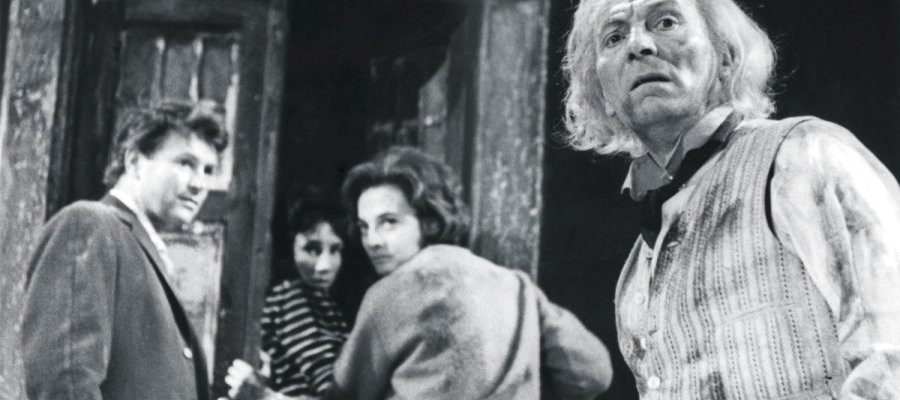Publishing Who
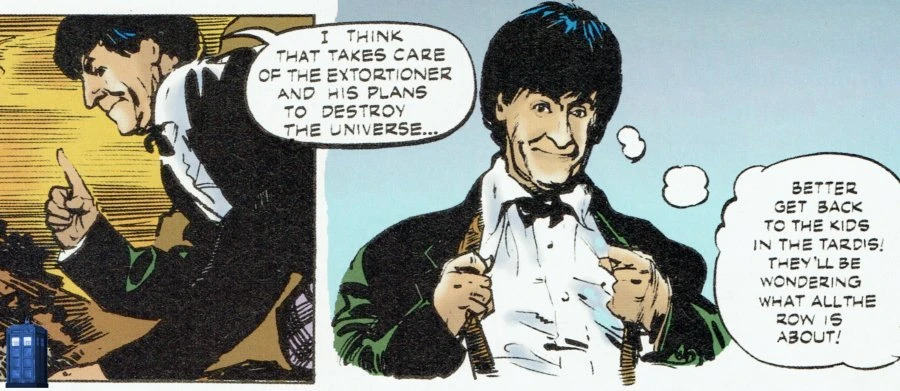
The History of Doctor Who in Print 1963 – 2005
Today a Doctor Who fan is spoilt for choice if he/she wants to find a book that covers the making of the series, a book that documents the Doctor's television adventures, or just wants to read new fictional adventures based on the series, but it took a long time for that to come about. Back in 1963, when the series first began, television-related merchandising was quite uncommon and certainly the BBC were not geared towards such ideas.
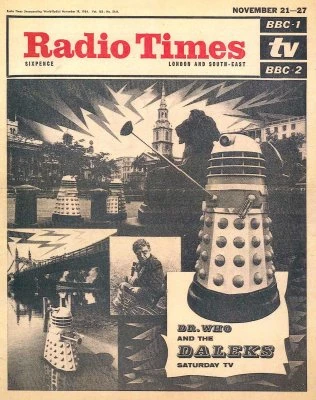
It can be argued with some justification that it was the ITV shows that in general captured the imagination of children more at this period, particularly with regard to the series produced by Gerry and Sylvia Anderson such as Four Feather Falls and Supercar. The BBC were caught completely cold-footed by the overnight success of the Daleks - not so writer Terry Nation, who had shrewdly retained part-copyright of his monstrous creations. Although the BBC were lethargic in promoting their own success - it wasn't until the second Dalek serial that the BBC made any effort themselves and then only by putting them on the cover of the Radio Times - there was a queue of other companies with marketing ideas asking for a licence to use the metallic meanies.

As early as June 1964 - just five months after the first Dalek story had finished airing on tv - Souvenir Press and Panther Books published "The Dalek Book", a collection of illustrated text stories written by Terry Nation and Dr Who script editor David Whitaker. Also, in this annual-type book were comic strips and even a photo strip which made use of stills from the Dalek serial.
"The Dalek Book" had managed to get in a few months ahead of the rest of the market - generally Dr Who and Dalek related merchandise seems to have appeared en masse from about November 1964, doubtless in a bid to capitalise on the second Dalek story, "The Dalek Invasion of Earth" which was airing at the time and also of course Christmas.
So successful was this publication that two others followed - "The Dalek World" in October 1965 and "The Dalek Outer Space Book" in September 1966, still with contributions from Nation who also used the character of Sara Kingdom from the tv story "The Dalek Masterplan".

Books available at this time included the first ever Doctor Who novel - the infamously titled "Doctor Who In An Exciting Adventure With The Daleks", written by David Whitaker for publishers Frederick Muller. Although the title has since been simplified to a less sensational "Doctor Who - The Daleks" Whitaker's novel, based on Terry Nation's first Dalek adventure and told from the viewpoint of the Ian Chesterton character, has stood the test of time and is still available today (It's recently been re-released and lavishly illustrated with new drawings by acclaimed comic book artist Robert Hack) and is rightly regarded as one of the best Who novelisations of all. It led to Frederick Muller quickly following it up with novelisations of "Doctor Who and The Crusaders" (Whitaker again) and "Doctor Who and The Zarbi" (by Bill Strutton).
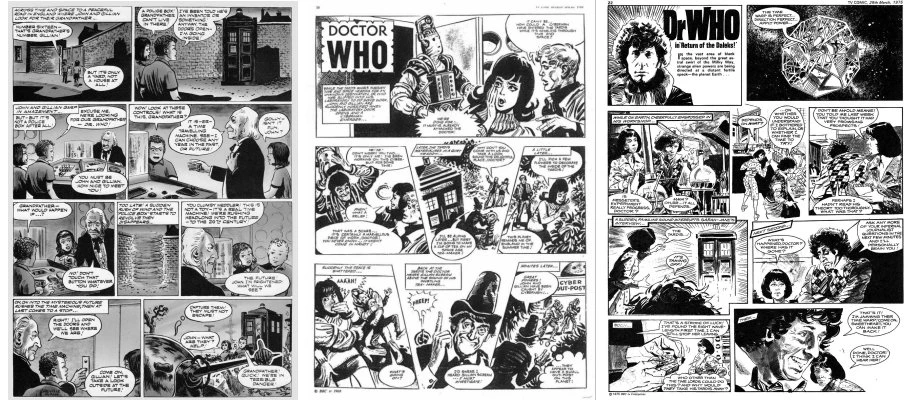
The children's weekly comic, TV Comic, acquired the licence to run a Doctor Who comic strip which began in issue 674, dated 14 November 1964. The tight production schedule combined with the reluctance of the Dr Who production team to leak details of forthcoming adventures meant that the comic strip always had to remain a separate entity that only very rarely mirrored events or happenings in the TV series. This has meant that Doctor Who has bizarrely had two parallel lives for whilst the Doctor, his granddaughter Susan and two human companions Ian and Barbara were travelling the universe on TV, Neville Main's comic strip had the Doctor in entirely different adventures with his grandchildren John and Gillian. Like the tv show, the comic strip got off to a cracking start with the two children finding the TARDIS in a yard and accidentally sending it off as the Doctor issues the immortal line "No! Don't touch that button whatever you do!" The Doctor naturally resembled actor William Hartnell, though one wonders whether Hartnell had any say in the use of his likeness given the BBC's limited procedures at the time. Certainly actress Anneke Wills, who played companion Polly in the mid-sixties, could not recall being consulted about merchandise during her time on the show.
The comic strip adventures were often more juvenile and more fantastical without the restraints of a tv budget. Although the Zarbi made an appearance, the Daleks were conspicuous by their absence. John Canning, who took over the strip, tried to make up for this by creating a similar foe for the Doctor to have recurring battles with - the Trods.
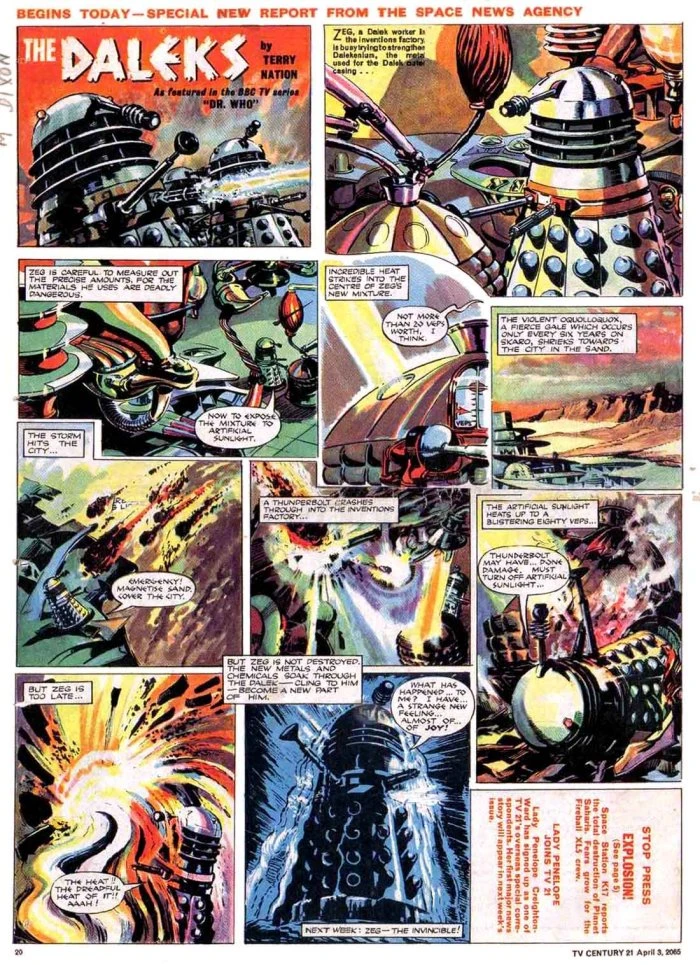
The reason the Daleks did not make an appearance was simple - their rights were held by City Magazines, who were running a Dalek strip in TV Century 21 (often referred to as just TV21 ), a lavish comic magazine centred mainly around the various Anderson-produced Supermarionation series. This strip had a less inspired start with some very inaccurate depictions of the Daleks in the initial instalments, but once it got into its stride - particularly when Ron Turner began drawing it - it became as good a comic strip as was seen anywhere in the 1960s and is rightly held up today as a classic. It ran for two years, from January 1965 until January 1967.
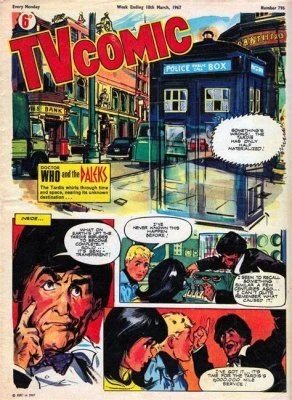
By this time the Doctor on TV had metamorphosed into the form of actor Patrick Troughton and, likewise, had done so in the TV Comic storyline (without explanation!) from the 24 December 1966 issue. TV Comic took up the rights to use the Daleks with alacrity as soon as they became available and made full use of them, having them appear in virtually every other story. They even had the Daleks, rather cruelly, engage the Trods in battle, trouncing them completely. Other television foes to appear in the comic strip during the second Doctor's tenure were the Quarks (which caused a huge row between the BBC and the Quark's creators, Haisman and Lincoln, who had not given permission for their use) and the Cybermen, who continued to maintain their original "Tenth Planet" form owing to artist John Canning not being given any updated reference photos!
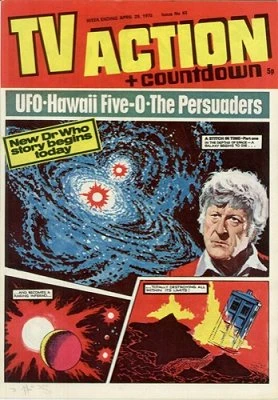
Polystyle Publications, who produced TV Comic, still held the rights for the strip in the seventies, and duly transformed the second Doctor into the third when the need arose. However, whilst TV Comic was for a generally juvenile readership, Polystyle had plans for a similar title for older readers and so the Doctor Who strip found itself transferred to the pages of TV Action & Countdown taking on a more serious approach with some stunning colour artwork from Gerry Haylock. For the first time, the Dr Who strip was beginning to rival the quality of the old Dalek strips. An interesting bit of trivia was that the Doctor's home planet of Gallifrey was actually first named not on tv but in the pages of TV Comic a few weeks before!
TV Action did not last though and Dr Who was already back in TV Comic by the time the fourth Doctor took over. The quality dipped again, and John Canning resumed artistic duties.

In 1979 the British wing of Marvel Comics bought up the Dr Who rights in order to produce "Doctor Who Weekly" and thus the continuance of the comic strip, which had only ceased in TV Comic the previous year, was assured. The rapid rise of 2000AD had seen British writers and artists take on a new prominence and Marvel acquired many of these talents for its Doctor Who comic strip, initially with Dave Gibbons as artist. The writers, which included Pat Mills and Steve Moore, were more in tune with the TV series and the strip became more faithful to it. There was also back-up strips centred not around the Doctor but his fearsome foes and these often outclassed the main strip - Abslom Daak, Dalek Killer became a hit character in his own right. As soon as rights could be acquired, K-9 joined the main strip but it wasn't to be until 1985 that Nicola Bryant's Peri took her place alongside the comic strip sixth Doctor - before that he had been accompanied by an alien shapeshifter, Frobisher, who had a liking for the form of a penguin!
The Marvel strip at this time had become a victim of its own success - the outstanding talents of Dave Gibbons, Mick Austin, Mike McMahon et al were tempted overseas where they could earn greater sums and Marvel had to find replacements. The sixth Doctor was generally well-served by artist John Ridgway but following his departure it was very much a hit and miss affair. Once the TV series had ended in 1989, Marvel tried experimenting with the strip far more, and rather than stick with the last (seventh) Doctor they tried stories with the earlier incarnations, until in 1996 a new eighth doctor appeared on screen - and the comic strip adopted him.
Marvel's comic strip briefly crossed the Atlantic and was published in the US, first as a trial in "Marvel Premiere" for four issues in 1980, then in its own comic book "Doctor Who" in the mid-80s. It was not the first time that there had been a Dr Who comic book in America - way back in the sixties Dell Comics had published a one-off special adapting the first Dalek movie, the only comic strip adaptation of a Dr Who adventure to date, save for a few short scenes from “Colony In Space” and “Terror Of The Zygons” in the Radio Times and “The Masque Of Mandragora” and “Terror Of The Autons” in the Marvel publication.
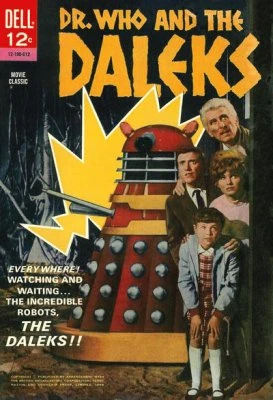
So much for the strip itself - the longest TV tie-in strip of all, but Marvel's Doctor Who Weekly has changed quite a bit since 1979 when it was aimed at young readers and was heavy with comic strip. Within a year (from issue 44 in fact) it had transformed into Doctor Who Monthly and gradually shed much of its comic strip content in favour of detailed articles looking at the tv show and its background. By the nineties it was producing an issue every four weeks, 13 a year, and was known as Doctor Who Magazine. It became more and more adult in its approach and developed into a vital source of news and information for the show's fans, something that TV Comic had never attempted to be.
The most notable entry in the world of Dr Who comic strips has to be a one-off special, "Dr Who - The Age Of Chaos", published by Marvel in 1994, an original adventure featuring the sixth doctor. Notable because it was written by the sixth doctor himself, actor Colin Baker!!!
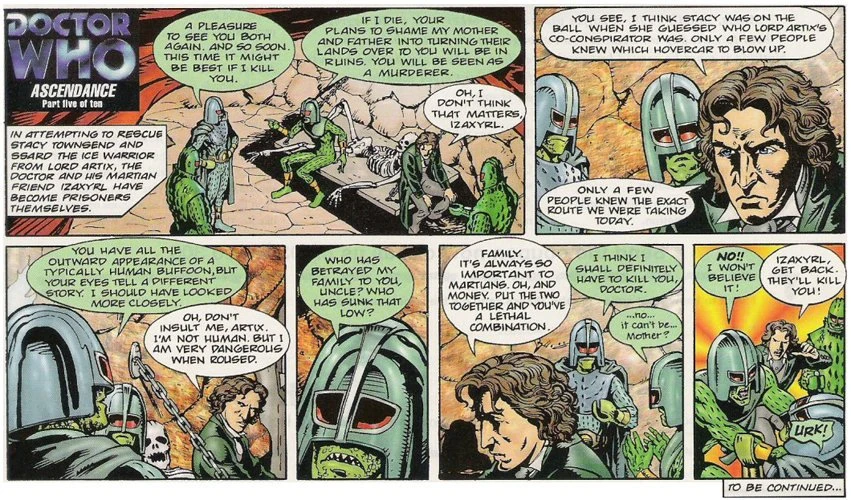
The Radio Times ran a comic strip for a while in the mid-90s, the most-sustained attention it ever paid to the series.
Information on the series had been very scarce in the sixties as most merchandise back then tended to be a toy of some sort. The earliest publication to seriously attempt to chronicle the series in anyway was a 1972 Piccolo paperback, "The Making Of Doctor Who" by Malcolm Hulke and Terrance Dicks. The information was still very limited though, a rather patchy account of the Doctor's TV adventures which used a clever but cumbersome idea of documenting them through reports from UNIT and the Time Lords. The dreams of the series' fans only really came true in 1973 when the BBC leapt to their rescue with a Radio Times special to promote the series' 10th anniversary. A lavish magazine with lots of features and photos, it documented all the tv stories at that time with a brief synopsis of each - although it was ultimately to create much confusion with its titles for the early stories. It was decided to use the title of the opening episode of those stories as the overall story title which led to unusual ones such as "The Executioners" and "The Steel Sky". However, even today many fans cling to the belief that story two should be called "The Dead Planet" and it’s all down to this magazine!!!
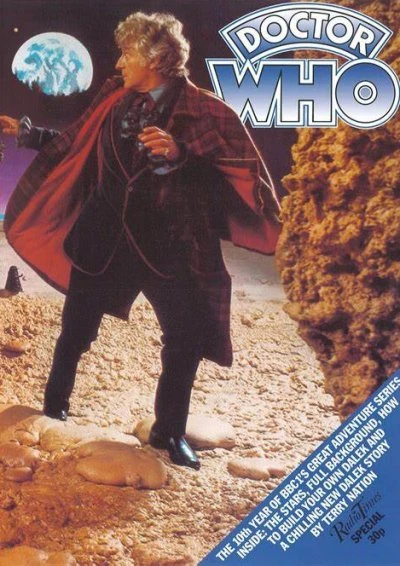
More detailed documentation of the doctor's adventures was to come. Target Books' successful 1973 reprinting of the three sixties novels (The Daleks, The Crusaders and The Zarbi) convinced them to add more titles to the range, starting with Terrance Dicks' adaptation of the first Jon Pertwee adventure, “Spearhead From Space”, as "Doctor Who And The Auton Invasion". This move proved to be a total success and continued unabated until, by the early nineties, every TV story had been novelised with the exception of one or two which had run into copyright difficulties.
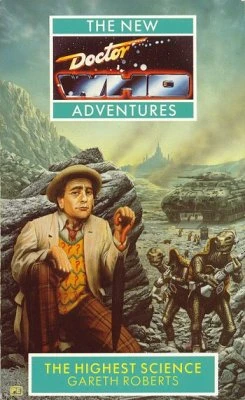
With no more TV stories to cover, Virgin Books, who now owned the franchise, was keen to continue and so commenced a new range entitled "The New Adventures", original novels which were set after the final TV story. These commenced with John Peel's "Timewyrm - Genesys" in 1991 and ended 61 novels later in 1997, by which time the BBC had woken up to reality and declined to renew Virgin's licence in order that they themselves could publish original Doctor Who fiction. Virgin also therefore lost the rights to their other string, "Doctor Who - The Missing Adventures" which were original novels featuring the earlier doctors, supposedly set between televised adventures. This range had run to 33 novels before the BBC pulled the plug. From 1997 the BBC continued these two ranges, but in their own name, with a series of eighth Doctor novels running alongside their past Doctor novels.
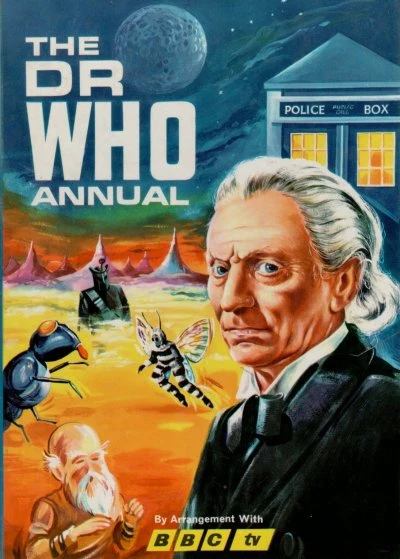
The earliest regular range of Doctor Who fiction books though was World Distributors' Doctor Who Annual, which first appeared in 1965 and continued until 1985, although no annual was produced in 1971. These largely comprised of illustrated text stories, the occasional comic strip and some generally uninspiring articles that were nothing to do with Doctor Who but sometimes had a scientific slant to them. Only in the eighties did a few features creep in that related to the series, usually relating to the design of props or costumes. The annuals were marked with various inaccuracies with some unusual depictions of Jo Grant or Leela for example, whilst the 1982 annual made the bold move of featuring two fifth doctor tales before he had even made his bow on television in Castrovalva.
The 1985 postponement and uncertainty over the series' future - plus declining sales of the annuals - led to World Distributors ceasing publication but Marvel decided to resurrect them in 1991 as The Doctor Who Yearbook, but this time with articles about the TV series taking precedence over fiction. However, Marvel also gave up after just five editions.
World Distributors had also tried other Doctor Who-related articles though. In a throwback to the sixties, they began publication of a Dalek Annual in 1975. These benefitted greatly from input by Terry Nation who divulged such secrets as to what the Kaled-Thal war was all about (from Genesis Of The Daleks) and foretold the return of Davros two years before Destiny of the Daleks hit the screens. It is no coincidence that the four Dalek annuals World produced from 1975 - 1978 are worth more than the Doctor Who annuals of the same period, for they are much superior publications.
World tried their luck with a K-9 Annual in 1982 following the K-9 And Company TV special but the lack of a series scuppered any chance of the annual becoming a permanent fixture.
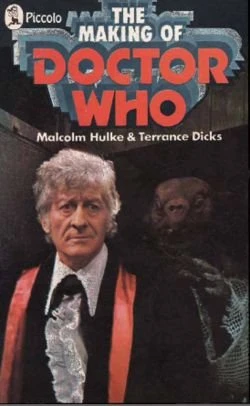
Factual books on the series did not end with The Making of Doctor Who in 1972, although it took a while for others to surface. Indeed, the next one was a reworking of the same book, still called The Making of Doctor Who but totally rewritten and updated by Terrance Dicks for Target Books in 1976. The old framework was discarded and instead stories were listed under titles - and somehow Dicks got most of the early story titles correct!
Target published the two-volume Doctor Who Programme Guide in 1981, written by Jean Marc L'Officier. The first book filled an important void by detailing every television story up to that time with title (and episodic titles where appropriate), broadcast dates, cast details and plot synopsis. The second volume was a rather weak encyclopaedia-type reference work.
W.H.Allen cashed in on the 20th anniversary with a large hardback tome by Peter Haining, "Dr Who - A Celebration: Two Decades Through Time And Space". It studied and interviewed each Doctor, including movie Doctor Peter Cushing, so often overlooked up until this time as well as the companions and each televised story. It sold well and Haining followed it up a year later with "The Key To Time", in effect a diary covering the programme's history from 1963 until 1984. Haining continued on an annual basis with "The Dr Who File", "The Time Travellers Guide" and "Doctor Who - 25 Glorious Years", although it was becoming apparent that he was running out of things to write about.
A little more worthwhile was "Doctor Who - The Early Years" by Jeremy Bentham, a good reference for the time (1986) but it suffers from only concentrating on the televised stories that were designed by Ray Cusick. As far as good reference works go, we had to wait until the nineties when Virgin published "Dr Who - The Sixties" (1992), "Dr Who - The Seventies" (1994) and "Dr Who - The Eighties" (1996) by Howe, Stammers and Walker. These, coupled with Virgin's range of Doctor Who handbooks (one for each of the seven BBC Doctors) also by Howe and Walker, must remain the definitive written guides to the series before the 21st century. The handbooks commenced publication in 1992 and were nearly scuppered when the BBC did not renew Virgin's licence in 1997 - but permission was duly granted to complete the range with The Seventh Doctor Handbook in 1998.
Not that a licence is always necessary to publish Doctor Who material. Adrian Rigelsford's "The Doctors - 30 Years Of Time Travel" in 1993 was published by Boxtree at a time when Virgin still held the Dr Who publishing rights. Fortunately for Virgin, the rival was not a good book, containing spelling mistakes, inaccuracies and some questionable interviews that deceased actors had supposedly given.
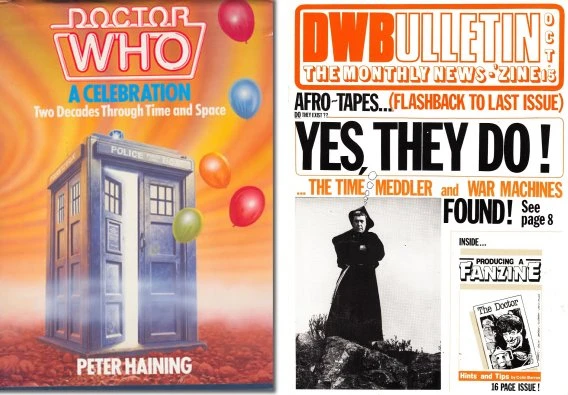
There is the world of Dr Who fanzines too, a vast array of magazines published by fans for fans - far too vast to detail here. These began to appear in the seventies but with DTP facilities available to anyone with a PC and printer by the late eighties, they did, in some cases, supercede the professional magazines of the past with Doctor Who Bulletin, The Frame and Nothing At The End Of The Lane being fan-made publications of particular quality.
There have been plenty of other Dr Who books from factual looks at the series (such as The Making of a Television Series) to factual looks at other topics (Doctor Who Discovers Early Man), to other fictional works (the Make Your Own Adventure books) to autobiographies from the actors to picture books (The Technical Manual, Timeview) to books that are way over my head (Dr Who - The Unfolding Text).
Since the 2005 revival of Doctor Who, publishing has really come into its own and is now a multi-million pound/dollar industry – but that’s for another time.
Written by David May






